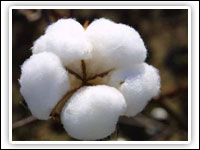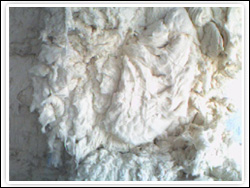






Raw Cotton & Wastes:
Raw Cotton:
 The history of cotton is a long and fascinating subject. The word "cotton" is an English version of the Arabic "qutun" or "kutun", a generic term meaning fancy fabric. But one of cotton's original popular names was "vegetable wool."
The history of cotton is a long and fascinating subject. The word "cotton" is an English version of the Arabic "qutun" or "kutun", a generic term meaning fancy fabric. But one of cotton's original popular names was "vegetable wool."
Cotton has been cultivated in many different parts of the world for more than 5,000 years. Even though people who grew and used it never came in contact with each other—in fact, some of them lived on different sides of an ocean, they still managed to develop similar tools to clean, prepare, spin, and weave it. Cotton was originally grown in several different colors, like brown, rust, and light purple. However, most of the cotton grown today is white. When mechanical processing methods were introduced it was easier to maintain a consistent color by using only white-fibered plants. Colored cotton is still grown, but at a small scale.
"The king of all fibers!" The quality of cotton supplied by us is simply unmatched to any other. With technological and process enhancement, we are ensuring the sustained demand of raw cotton and cater the needs of our clientele.

Parameters:
| Length | 20mm – 35mm |
| Mic | Up to 5mm |
| Strength (Gtex) | from 22 |
| Trash | 1.5% - 3.5 % |
| Moisture | Max 8% |


Comber Noil
 We provide one of the finest qualities Comber Noil which is a defect free product manufactured through 100% pure cotton. Comber Noil can be used for a number of purposes such as, production of pharmaceutical and surgical cotton. Besides this it can also be used in yarn production. We provide it in bale form as well which facilitate different uses for different users.
We provide one of the finest qualities Comber Noil which is a defect free product manufactured through 100% pure cotton. Comber Noil can be used for a number of purposes such as, production of pharmaceutical and surgical cotton. Besides this it can also be used in yarn production. We provide it in bale form as well which facilitate different uses for different users.


Cotton Waste:
 Cotton is the most commonly used fiber. It accounts for about 40 percent of total world fiber production. With the aim to cater to the increasing demand for this popular fiber and achieve optimal utilization, we are making available cotton yarn wastes that can be used for different textile materials.
Cotton is the most commonly used fiber. It accounts for about 40 percent of total world fiber production. With the aim to cater to the increasing demand for this popular fiber and achieve optimal utilization, we are making available cotton yarn wastes that can be used for different textile materials.
Almost all parts of the cotton plant are used in some way, including the cottonseed, lint (raw cotton fibre), stalk and hull (shell). For example, popular uses for cotton fibre include clothing apparel such as denim jeans, socks, towels, t-shirts, bed sheets and underwear, home furnishings and industrial/medical products such as tents, bandages and cotton swabs .

